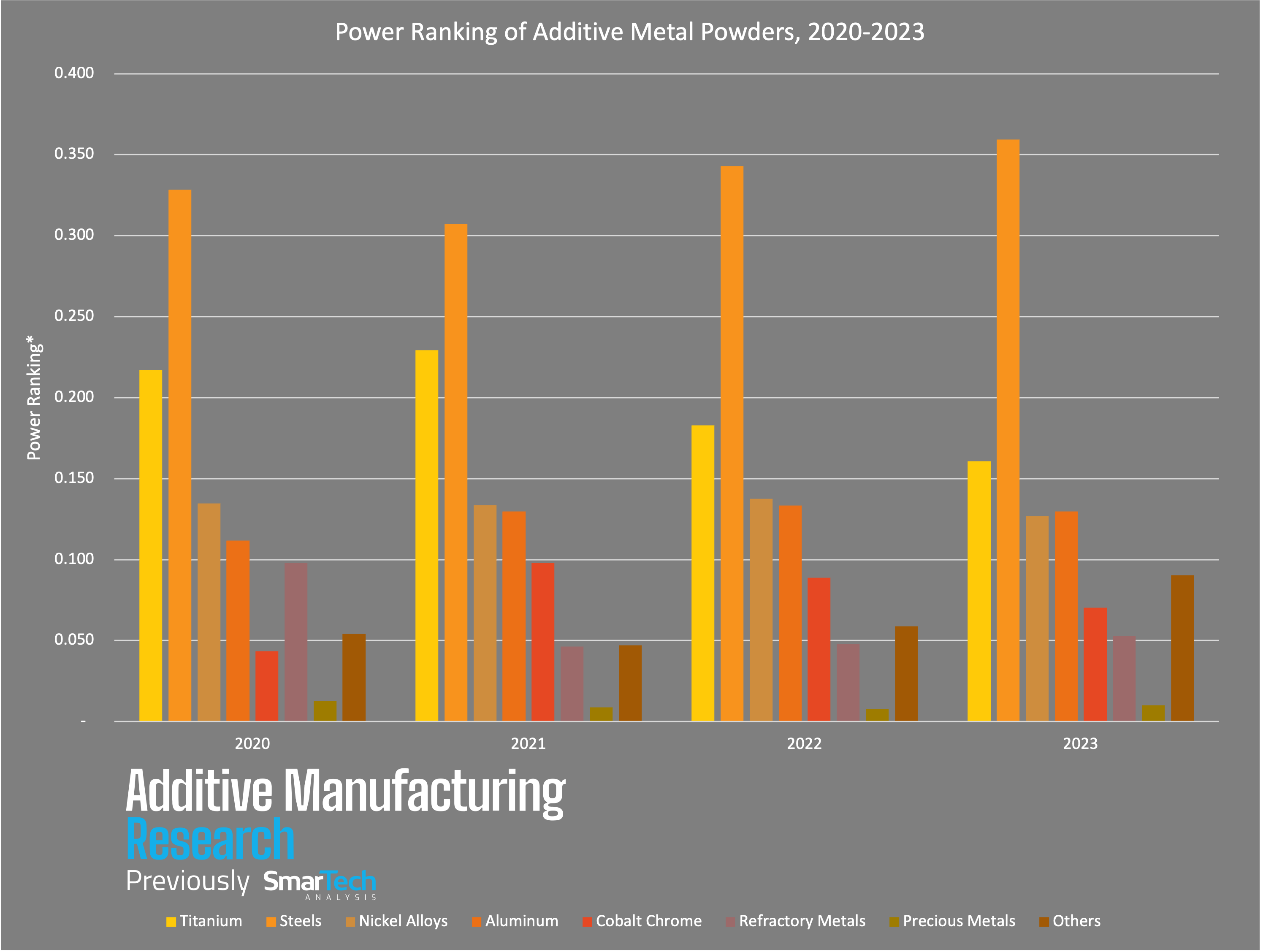“AM Data Slice” from Additive Manufacturing Research (AMR) is a weekly segment that offers readers a dive into the additive manufacturing (AM) landscape, showcasing pivotal statistics and trends derived from AMR’s exhaustive research. The latest chart provides AMR’s “Power Ranking” of various metal types in metal AM powders.
In tracking the metal powder market, it’s important to balance out such factors as growth and volumes. For instance, materials that ship in smaller volumes annually may have higher growth rates. Additionally, metals have different densities, so tracking the mass of powder shipments doesn’t tell the full story. In the case of aluminum, a ton of powder represents much more volume than a ton of steel.
Thus, in order to properly compare how important a metal is to the overall 3D printing market, AMR has developed the Power Ranking. The total market share of the volume of each metal powder type in a given year has been multiplied by the growth rate (given as a percentage) of that metal’s powder shipments in the same year. This value is multiplied by 100 to give the raw ranking, which is then divided into the total sum of all rank values in a given year to normalize for comparison across years.

Looking at the most recent Power Ranking chart from AMR reveals some interesting trends. Titanium, for instance, shows a prominent position within the ranking. This is indicative of its vital role in AM due to its strength-to-weight ratio and corrosion resistance, making it desirable for aerospace and medical applications. On the other hand, steels demonstrate a consistent presence, underlying their foundational role in various industries due to their versatility and performance.
Nickel alloys also command attention, due to their high-performance characteristics in extreme environments, making them indispensable in sectors such as aerospace and energy. Meanwhile, aluminum’s ranking highlights its growing popularity, owed to its lightness and the push for more fuel-efficient components in the automotive and aerospace sectors.
Other categories, like cobalt chrome, refractory metals, precious metals, and others, though smaller in volume, show varying degrees of growth and market share, reflecting niche applications or emerging trends in the AM landscape.
The chart not only serves as a snapshot of the current state but also as a predictive tool for future trends. For instance, metals with high growth rates but smaller volumes might indicate emerging materials that could disrupt the market if their application scope widens.
Subscribe to Our Email Newsletter
Stay up-to-date on all the latest news from the 3D printing industry and receive information and offers from third party vendors.
You May Also Like
3D Printing Unpeeled: Biofuel Waste to Filament & Sustainable Photopolymers
I can’t ever remember a day with so many potentially high impact news stories have come out. In one story, we all know that there are problems with the safety...
Finnair Hires AM Craft to 3D Print Plastic Parts for Aircraft Interiors
Riga-based AM Craft, a supplier specialized in 3D printing aviation components and certified under EASA Part 21G, announced a significant achievement today. The company will assist in upgrading Finnair’s A320...
3DPOD Episode 198: High Speed Sintering with Neil Hopkinson, VP of AM at Stratasys
Neil Hopkinson, a pioneering 3D printing researcher, played a pivotal role in developing a body of research that is widely utilized today. He also invented High Speed Sintering (HSS), also...
3D Printing Webinar and Event Roundup: May 12, 2024
Webinars and events are picking up in the AM industry this week! ASTM International continues its Professional Certificate Course and Stratasys continues its advanced in-person trainings, while 3D Systems is...
































